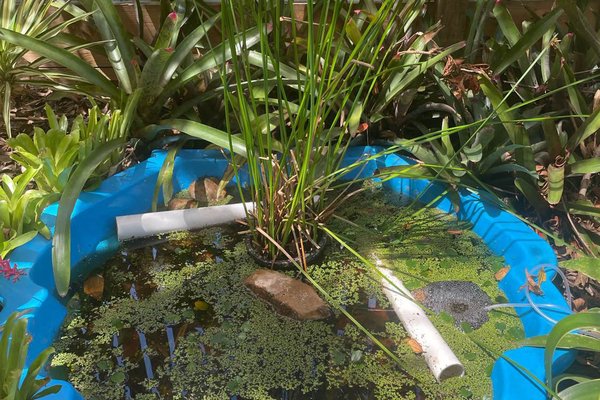It’s hard to live in the city: the decline of frog species from our urban areas
How are frogs faring across Australia, from bushland to your backyard? Are frogs persisting, even in the most built-up of areas? In a recent study, FrogID data helps us understand how frogs in Australia respond to urbanisation.
Urban areas are unique environments for animals, as key habitats are usually fragmented or highly modified for human use. Additionally, cities often have increased pollutants from industrial and household chemicals, traffic noise and light pollution. This can cause animals to migrate from urban habitats, change the way they communicate with one another, or alter certain behaviours such as foraging. Some animals do not appear to be bothered by these additional stressors, such as the well-known Australian ibis (Threskiornis moluccus) which has adapted well to the urban lifestyle.
However, not all species are cut out for the city life. These species struggle to tolerate the changes and usually make the move to live in the ‘quieter’ outer suburbs. To avoid potential biodiversity losses within our cities, it is paramount that we understand how different animals are responding to urbanisation.
One group of animals that is declining rapidly across the globe, with the unenviable position of being one of the most threatened vertebrate groups, are frogs. Despite their predicament and their important role in healthy ecosystems, we know very little about them, including how they fare in our ever-growing cities.
To understand how frog diversity is changing due to urbanisation, we used data collected by citizen scientists for the Australian Museum’s FrogID project, which has generated over 300,000 frog records for over 200 frog species since its inception in late 2017! This allowed us to look at data from across the entirety of Australia, rather than at a local or regional scale, for the very first time.

Citizen scientist recording frog calls with the FrogID app.
Image: Jodi Rowley© Australian Museum
We found that the number of frog species in cities across Australia was less than half (59% lower) than in natural areas. When we consider species diversity, the picture was just as grim. Shannon diversity (which considers the number of records per species) was 59% lower in cities than natural areas. Similarly, phylogenetic diversity (which takes into consideration how closely related species are to one another) was a staggering 79% lower! Additionally, less than half the threatened species found in natural areas were found in urbanised habitats.
There was some good news, however. Out of 196 frog species in Australia that we had enough data for, 60% (118 species) could still be found in urban areas and interestingly, one species, the Northern Trilling Frog (Neobatrachus aquilonius), was only found in urban areas. However, this frog only has six records in FrogID, so we definitely need more citizen scientists to help record it! In addition, cities provided habitat for threatened species such as the Red Crowned Toadlet (Pseudophryne australis), demonstrating that cities can be important places for biodiversity conservation, even for threatened species.

The threatened Red Crowned Toadlet (Pseudophryne australis) that can be found in some of Australia's urban areas.
Image: Jodi Rowley© Australian Museum
Our findings have made it clearer than ever that frogs need to be considered in both current and future urban planning and land development decisions. Correctly managing key habitats within urban areas (even at small scales) has been shown to increase frog diversity. Keeping natural areas within our cities can really help frog populations, and the FrogID project is providing us with data that can help us answer follow-up questions such as “what frog species are likely to be urban-tolerant?” or “what types of habitat best support diversity in urban areas?”.
Frogs are quite sensitive to the changes in their environment, and like canaries in the coalmines, they are usually the first to respond to negative impacts. So, where we see frogs declining and disappearing, it is likely that other animals are affected too. By understanding how frogs are responding to our ever-changing environments and by considering them in urban planning, we are likely providing habitat that benefits the rest of our biodiversity too.
Brittany Mitchell, PhD Candidate, Herpetology, Australian Museum Research Institute; and, Centre for Ecosystem Science, School of BEES, UNSW Sydney.
More information:
Callaghan, C.T., Liu, G., Mitchell, B.A, Poore, A.G.B, Rowley, J.LL., (2021) Urbanization negatively impacts frog diversity at continental, regional, and local scales. Basic and Applied Ecology, 54: 64-74.
Acknowledgements:
We would like to thank the Citizen Science Grants of the Australian Government for providing funding for the FrogID project; the Impact Grants program of IBM Australia for providing the resources to build the FrogID App; Bunnings, Fyna Foods for supporting FrogID as project partners; the generous donors who provided funding for the project including John T Reid Charitable Trusts; the Museum and Art Gallery of the Northern Territory, Museums Victoria, Queensland Museum, South Australian Museum, Tasmanian Museum and Art Gallery, and Western Australian Museum as FrogID partner museums; the many Australian Museum staff and volunteers who make up the FrogID team; and, most importantly, the thousands of citizen scientists across Australia who have volunteered their time to record frogs.















